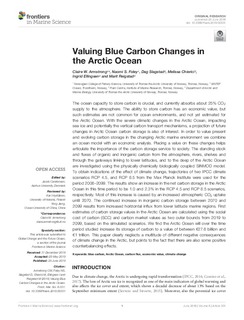| dc.contributor.author | Armstrong, Claire W. | |
| dc.contributor.author | Foley, Naomi | |
| dc.contributor.author | Slagstad, Dag | |
| dc.contributor.author | Chierici, Melissa | |
| dc.contributor.author | Ellingsen, Ingrid H. | |
| dc.contributor.author | Reigstad, Marit | |
| dc.date.accessioned | 2019-09-12T08:37:06Z | |
| dc.date.available | 2019-09-12T08:37:06Z | |
| dc.date.created | 2019-09-03T17:02:25Z | |
| dc.date.issued | 2019-06-25 | |
| dc.identifier.citation | Frontiers in Marine Science. 2019, 6:331 1-12. | nb_NO |
| dc.identifier.issn | 2296-7745 | |
| dc.identifier.uri | http://hdl.handle.net/11250/2616500 | |
| dc.description.abstract | The ocean capacity to store carbon is crucial, and currently absorbs about 25% CO2 supply to the atmosphere. The ability to store carbon has an economic value, but such estimates are not common for ocean environments, and not yet estimated for the Arctic Ocean. With the severe climatic changes in the Arctic Ocean, impacting sea ice and potentially the vertical carbon transport mechanisms, a projection of future changes in Arctic Ocean carbon storage is also of interest. In order to value present and evolving carbon storage in the changing Arctic marine environment we combine an ocean model with an economic analysis. Placing a value on these changes helps articulate the importance of the carbon storage service to society. The standing stock and fluxes of organic and inorganic carbon from the atmosphere, rivers, shelves and through the gateways linking to lower latitudes, and to the deep of the Arctic Ocean are investigated using the physically chemically biologically coupled SINMOD model. To obtain indications of the effect of climate change, trajectories of two IPCC climate scenarios RCP 4.5, and RCP 8.5 from the Max Planck Institute were used for the period 2006–2099. The results show an increase in the net carbon storage in the Arctic Ocean in this time period to be 1.0 and 2.3% in the RCP 4.5 and RCP 8.5 scenarios, respectively. Most of this increase is caused by an increased atmospheric CO2 uptake until 2070. The continued increase in inorganic carbon storage between 2070 and 2099 results from increased horizontal influx from lower latitude marine regions. First estimates of carbon storage values in the Arctic Ocean are calculated using the social cost of carbon (SCC) and carbon market values as two outer bounds from 2019 to 2099, based on the simulated scenarios. We find the Arctic Ocean will over the time period studied increase its storage of carbon to a value of between €27.6 billion and €1 trillion. This paper clearly neglects a multitude of different negative consequences of climate change in the Arctic, but points to the fact that there are also some positive counterbalancing effects. | nb_NO |
| dc.language.iso | eng | nb_NO |
| dc.rights | Navngivelse 4.0 Internasjonal | * |
| dc.rights.uri | http://creativecommons.org/licenses/by/4.0/deed.no | * |
| dc.subject | blue carbon | nb_NO |
| dc.subject | Arctic Ocean | nb_NO |
| dc.subject | carbon flux | nb_NO |
| dc.subject | economic value | nb_NO |
| dc.subject | climate change | nb_NO |
| dc.title | Valuing blue carbon changes in the Arctic ocean | nb_NO |
| dc.type | Journal article | nb_NO |
| dc.type | Peer reviewed | nb_NO |
| dc.description.version | publishedVersion | nb_NO |
| dc.rights.holder | Copyright © 2019 Armstrong, Foley, Slagstad, Chierici, Ellingsen and Reigstad. This is an open-access article distributed under the terms of the Creative Commons Attribution License (CC BY). The use, distribution or reproduction in other forums is permitted, provided the original author(s) and the copyright owner(s) are credited and that the original publication in this journal is cited, in accordance with accepted academic practice. No use, distribution or reproduction is permitted which does not comply with these terms. | nb_NO |
| dc.source.pagenumber | 1-12 | nb_NO |
| dc.source.volume | 6:331 | nb_NO |
| dc.source.journal | Frontiers in Marine Science | nb_NO |
| dc.identifier.doi | 10.3389/fmars.2019.00331 | |
| dc.identifier.cristin | 1721167 | |
| cristin.unitcode | 7566,6,0,0 | |
| cristin.unitname | Miljø og nye ressurser | |
| cristin.ispublished | true | |
| cristin.fulltext | original | |
| cristin.qualitycode | 1 | |

